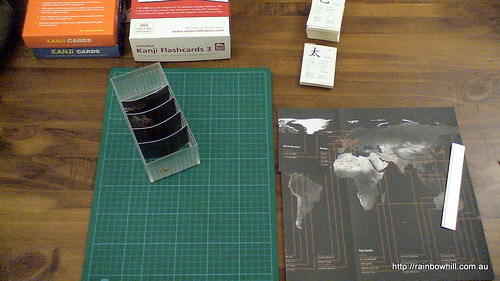Earlier this year I set myself the challenge to review the 2000 jōyō kanji by December when I plan to re-sit the Japanese Language Proficiency Test. The problem that I face daily is how to manage my flashcards efficiently so that kanji I know well moves back into the box. Ideally I don't want to carry cards that I know well so I can increase my kanji learning rate.
I was recently given a set of Kanji Flashcards from White Rabbit Press to review, but before I do I want to put them to good use. I already own a set of Tuttle Kanji Cards so it seems like a perfect opportunity to do a comparison as I work my way through the jōyō kanji. I'm using a learning technique called spaced repetition that incorporates increasing intervals between the review of each known kanji.

Leitner Box Preparation - Four by Rainbowhill LL, on Flickr
What is Spaced Repetition?
You may be familiar with smart.fm, supermemo, memnosyne or anki. All of these online learning tools are basically flashcard systems that automate the process of presenting material for revision. This learning technique has actually been around well over hundred years, and exploits a psychological phenomenon known as the spacing effect. The spacing effect was first described by Hermann Ebbinghaus in 1885, and suggests that cramming is less effective than regular study at intervals over a longer period of time.
Spaced repetition solves the problem of what to study next, and when. It optimises the presentation of material for review at a point when you should be just about to forget it. With a lot to study this can be difficult to organise without software. I wanted to try something strictly analogue, but not something that would take more time to organise that it does to study.
Piotr Wozniak, the inventor of Supermemo and developer of the algorithm that forms the basis of many Spaced Repetition Services, describes a method of using spaced repetition without a computer. It looks like too much hard work to me, and might actually distract me from actually learning anything. Instead I decided on using the far simpler Leitner system.
How does the Leitner system work?
Flashcards are sorted into groups according to how well you know them. Each correctly answered card moves into a deck that is studied less frequently. When you are starting out there is only one group. You test yourself with cards from the first group so the ones you know move to the next less frequently tested group. The decision about how many groups you have, and how often they are studied is up to you.
The most basic method sorts cards into three groups, current cards, unknown cards and known cards. I've been using this method inadvertantly for years, with a rubber band and two card dividers. The main problem with this system is that known cards are moved back into the box without revision and soon forgotten.
This time around I am using Leitner's learning box, which allows a larger number of groups according to your progress with the cards. Intervals can be hard to manage, particularly if you start with a large number of cards and repetitions can soon get out of hand. To make things simpler I've labelled the groups in the box current, every-other-day, twice-a-week, once-a-week, and retired. If I miss a day, I'm not too fussed, I just pick my repetitions up the very next day where I left off.
What I am starting to notice is that with at least three spaced repetitions for each card over a week or more, by the time the cards make it into the retired group I'm more confident I won't need to review them again. Hopefully this will allow me to get through a much larger number of revisions in a shorter amount of time.
Six steps to a simplified Leitner system
- Start with a set of cards.
- Test yourself on how well you know them.
- Move the cards you know to the next group, and the ones you don't back into the current group.
- Review the cards in the second group a day later and repeat the process.
- The next group of cards review again every-other-day, the next group twice-a-week and the last group once-a-week.
- When the cards you know have reached the end of Leitner's learning box, retire them.
I'll let you know how I go with my progress, follow me on Twitter.
Do you use flashcards? Do you spend more time on organising your study than doing it? What works for you? I'd like to hear how you crush your kanji repetitions in the comments below.


